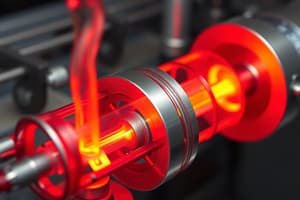Podcast
Questions and Answers
What is the characteristic of a system with an adiabatic boundary?
What is the characteristic of a system with an adiabatic boundary?
- Allows exchange of work
- Is in its own internal thermodynamic equilibrium
- Does not allow heat exchange (correct)
- Allows mass flow
Which type of system does not allow exchange of mass and energy?
Which type of system does not allow exchange of mass and energy?
- Thermally isolated system
- Isolated system (correct)
- Open system
- Closed system
What is the term for a system that is mechanically isolated?
What is the term for a system that is mechanically isolated?
- Adiabatic boundary
- Isothermal system
- Thermally isolated
- Rigid boundary (correct)
What is the term for a characteristic of a system, such as pressure or temperature?
What is the term for a characteristic of a system, such as pressure or temperature?
What type of system allows exchange of both mass and energy?
What type of system allows exchange of both mass and energy?
What is the ideal state of an isolated system?
What is the ideal state of an isolated system?
What determines whether a physical property is classified as intensive or extensive?
What determines whether a physical property is classified as intensive or extensive?
What is a quasi-equilibrium process?
What is a quasi-equilibrium process?
What is a characteristic of an intensive property?
What is a characteristic of an intensive property?
What is an example of an extensive property?
What is an example of an extensive property?
What is a characteristic of a quasi-equilibrium process?
What is a characteristic of a quasi-equilibrium process?
What is the definition of a path in thermodynamics?
What is the definition of a path in thermodynamics?
What happens to the hardness of a diamond when it is cut into smaller pieces?
What happens to the hardness of a diamond when it is cut into smaller pieces?
Which of the following is an example of a state variable?
Which of the following is an example of a state variable?
What is the difference between an intensive and an extensive property?
What is the difference between an intensive and an extensive property?
What is the term for the concept that smaller, non-interacting identical subdivisions of the system may be identified?
What is the term for the concept that smaller, non-interacting identical subdivisions of the system may be identified?
What is a characteristic of state variables?
What is a characteristic of state variables?
Which of the following is NOT a state variable?
Which of the following is NOT a state variable?
What is a common use of PV diagrams in thermodynamics?
What is a common use of PV diagrams in thermodynamics?
What is a characteristic of a state variable?
What is a characteristic of a state variable?
What is the purpose of an indicator diagram in a steam engine?
What is the purpose of an indicator diagram in a steam engine?
What is required for a process to be considered reversible?
What is required for a process to be considered reversible?
What is the relationship between the area enclosed by the PV curve and the work done by the system?
What is the relationship between the area enclosed by the PV curve and the work done by the system?
What is plotted on the x-axis in some cases instead of volume in a PV diagram?
What is plotted on the x-axis in some cases instead of volume in a PV diagram?
What happens to the system and its surroundings after a reversible cycle?
What happens to the system and its surroundings after a reversible cycle?
Why is it necessary to calculate the integral of the pressure with respect to volume?
Why is it necessary to calculate the integral of the pressure with respect to volume?
Why are perfectly reversible processes impossible?
Why are perfectly reversible processes impossible?
What is an alternative definition of a reversible process?
What is an alternative definition of a reversible process?
What is the context in which PV diagrams are commonly used?
What is the context in which PV diagrams are commonly used?
What does it mean for a process to 'take place' in thermodynamic terms?
What does it mean for a process to 'take place' in thermodynamic terms?
An isobaric process is a thermodynamic process in which the volume remains constant.
An isobaric process is a thermodynamic process in which the volume remains constant.
Isochoric process is exemplified by the heating or the cooling of the contents of a sealed, elastic container.
Isochoric process is exemplified by the heating or the cooling of the contents of a sealed, elastic container.
An adiabatic process is a process that allows the transfer of heat or matter between a system and its surroundings.
An adiabatic process is a process that allows the transfer of heat or matter between a system and its surroundings.
In an isobaric process, the volume is allowed to expand or contract to neutralize any pressure changes.
In an isobaric process, the volume is allowed to expand or contract to neutralize any pressure changes.
An isochoric process is a thermodynamic process during which the pressure of the closed system remains constant.
An isochoric process is a thermodynamic process during which the pressure of the closed system remains constant.
Adiabatic transfer provides a rigorous conceptual basis for the theory used to expound the second law of thermodynamics.
Adiabatic transfer provides a rigorous conceptual basis for the theory used to expound the second law of thermodynamics.
In an isochoric process, the volume of the closed system can expand or contract freely.
In an isochoric process, the volume of the closed system can expand or contract freely.
An isobaric process is a thermodynamic process in which the temperature remains constant.
An isobaric process is a thermodynamic process in which the temperature remains constant.
An adiabatic process is a reversible process.
An adiabatic process is a reversible process.
Isochoric process is a type of adiabatic process.
Isochoric process is a type of adiabatic process.
Flashcards are hidden until you start studying




